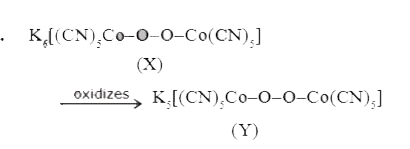A symmetricla bridged complex cation made of Co(III),NH3 molecules and oxygen (in the proper ligands form) is found to contain the following mass composition [Atomic mass of Co=59]
Co=36.875%, NH3=53.125%, O=10%
The complex cation exists in three ionic forms with cationic charges A : (n+),B(n−1)+ and C:(n−2)+ such that O-O bond length in all of them is found to be more than that in O2[Ptf6]. Calculate the value of n,(n−1) and (n−2).
Text Solution
The correct Answer is:654
Co:NH3:O36.87559:53.12517:10160.625:3.125:0.6251:5:1
Co2(NH3)10O2
0.5 of O2 can be 0,-1,-2
x can be 6,5,4
|
Topper's Solved these Questions
- COORDINATION COMPOUNDSBOOK - OP TANDONCHAPTER - COORDINATION COMPOUNDSEXERCISE - MATCH THE COLUMN TYPE
11 Videos
- CLASSIFICATION AND NOMENCLATURE OF ORGANIC COMPOUNDS BOOK - OP TANDONCHAPTER - CLASSIFICATION AND NOMENCLATURE OF ORGANIC COMPOUNDS EXERCISE - INTEGER
2 Videos
- ELECTROCHEMISTRYBOOK - OP TANDONCHAPTER - ELECTROCHEMISTRYEXERCISE - Matrix-Matching Type Question
3 Videos
Similar Questions
Knowledge Check
Which of the following cation forms inner orbital octahedral complex with NH3 ?
ANi2+BFe2+CPt2+DPt4+Which of the following cation forms inner orbital octahedral complex with NH3 ?
ANi2+BFe2+CPt2+DPt4+
In both the complexes Co cation have t62ge0g configuration.
The B. E. of (O–O) in X & Y isAB. E. of (O – O) in y lt B. E of (O – O) in XBB. E. of (O – O) in X lt B. E. of (O – O) in YCB. E. of (O – O) in X = B. E. of (O – O) in YDcan’t be compared
Which of the following species is not expected to be a ligand
⊕NO
NH⊕4
(c ) NH2−NH⊕3
(CO) .
View SolutionNH3 has pyramidal structure with HNH bond angle of 107∘ it forms complexes with cation which of the following does not form complex with NH3 ?
View SolutionN2andO2 are converted to mono cations N+2andO+2 respectively. Which is wrong ?
View SolutionAlum is found to contain hydrated monovalent cation [M(H2O)6]+,trivalent cation [M'(H2O)6]3+and SO2−4 in the ratio of
View SolutionCo3+ ion forms octahedral complex with ligands like F− and NH3 as [CoF6]3− and [Co(NH3)6]3+.
These two complexes differ in:
View Solution
